Shelter grapes for the winter: the best ways
Great importance in the cultivation of grapes and its autumn preparation for winter is attached to its shelter. However, not always and not all amateur gardeners know how to properly cover grapes for the winter.
- Why and when (in what time frame) is it necessary to do this?
- What are the features of the shelter in different regions (the Middle zone, Moscow region, the Urals and Siberia)?
You will learn about all this, as well as about the basic rules and the best ways to hide, their pros and cons, from our article.
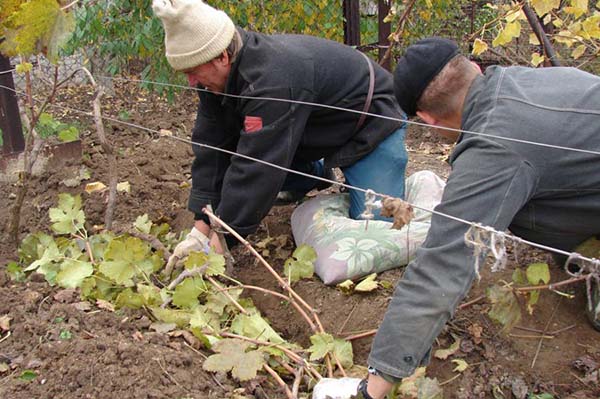
Content
- 1 Why shelter grapes for the winter
- 2 When to cover grapes in autumn: at what temperature
- 3 Features of the shelter of grapes in different regions
- 4 How to properly cover grapes for the winter: methods and rules
- 5 How to cover grapes: the best covering materials
- 6 Answers to popular questions about sheltering grapes for the winter
Why shelter grapes for the winter
To obtain a good and stable harvest in areas of risky agriculture (and accordingly, viticulture), grape bushes need a mandatory shelter for the winter.
Note! There are completely uncovered grape varieties (withstanding up to -35 degrees), however, as a rule, these are technical, and not table varieties.
Even if your temperature does not drop below -20 degrees, and most modern frost-resistant varieties easily tolerate them (average frost resistance of the main combs is about -20 ... -24 degrees), it is still better to cover grapes for the following reasons:
- If the bushes are not covered, but suddenly a thaw has come, the rains have started, and the frosts have returned again, then the whole vine is covered ice crust. If in this state the buds in the eyes of the bush stay for more than 2-3 days, then they will simply freeze and die.
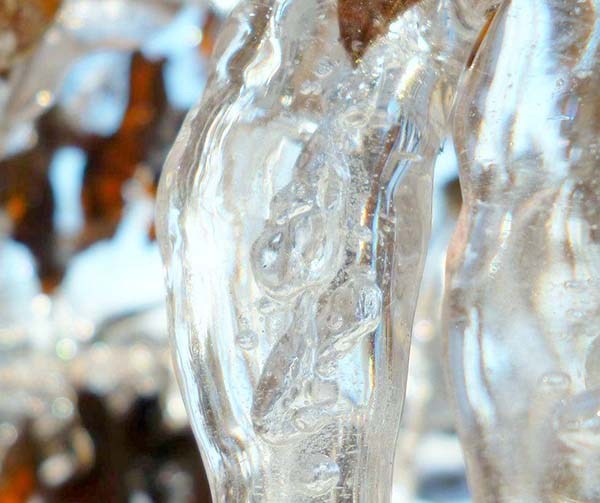
- When the grapes come out of physiological dormancy, they are forced to rest (approximately in January-February). If it is covered, then a fairly stable temperature is kept under the shelter and the plant continues to sleep. If the grapes are not covered, then due to thaws he wakes up and begins to prepare for the growing season, and the newly struck frosts, even small ones (up to -5 ..- 10 degrees), can severely damage the buds in the eyes, since the bush has already lost all winter hardiness after thaws.
- If in your place of residence there are strong winds, especially the northern and eastern ones, it is also recommended to shelter, because the wind accelerates the evaporation of moisture and, accordingly, the temperature decreases. Such a decrease may not be strong, only by a couple of degrees, but because of it, again, the kidney in the eye can freeze and die.
- Proper cover will helpprevent damage to the vine by rodents.
Advice! To prevent mice from gnawing grapes, before covering at the base, sprinkle wood ash or lime.
By the way! About, how to get rid of mice and other rodents at their summer cottage, you can read in detail in this article.
The reasons were listed above, as it were in theory, and in the next video the author shows what actually happens if the grapes are not covered for the winter, and what a covered vine looks like in spring.
Video: is it necessary to cover grapes - a conclusion based on the results of winter
Thus, sudden changes and jumps in temperature in winter (thaws) are the main reasons why grapes need to be covered for the winter.
When to cover grapes in autumn: at what temperature
You need to start covering the grapes only when at night it will be up to -5 ... -10 degrees, in the afternoon the temperature should be steadily below 0 degrees (0..-5).
But the most important condition for sheltering grapes is fully matured vine.
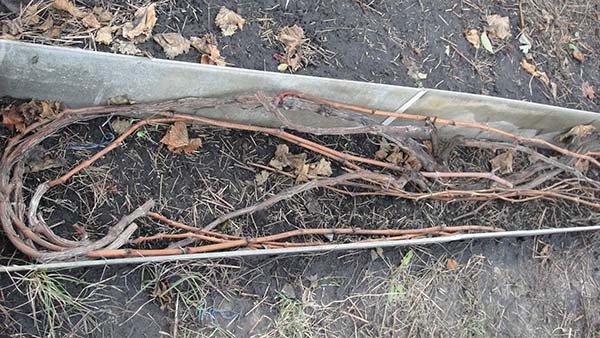
Note! Before wintering, the vine should temper (her immunity and winter hardiness will improve), so she must endure the first frosts in an uncovered state (but no more than 4-5 days).
If cover too early, when the autumn rains have not yet ended, the grapes will simply get wet, and then the frost will grab it and destroy it. If there are thaws (even without rain), it will trample. In addition, the vine must be fully ripe, green - 99% freeze. Therefore, all green shoots should be cut, otherwise they will start to rot and infect good vines.
Basically, if the vine is not yet ripe, but it is already sub-zero weather, the rains have already passed, then for a start it can be covered with acrylic or spunbond (the covering material should allow air and water to pass through).
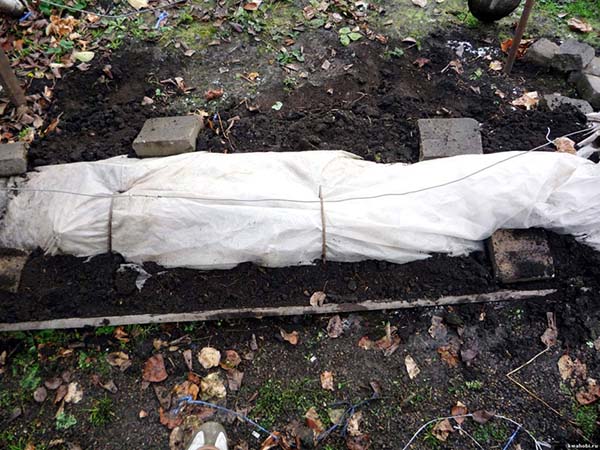
When the vine is fully ripe, it will be possible to close it, for example, with slate, roofing material, film, in other words, with a material that does not allow moisture to pass through.
Video: when and at what temperature to cover grape bushes for the winter
Features of the shelter of grapes in different regions
Due to the peculiarities of climatic conditions in different regions of the country, various methods of sheltering grapes are practiced.
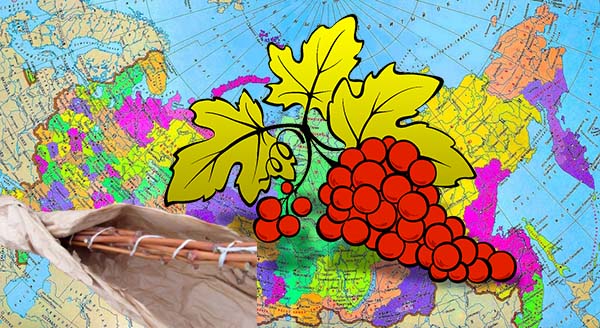
Do I need to cover grapes in the South of Russia
It is believed that in the southern regions, where the climate is warm enough, it is not necessary to cover the grapes for the winter. However, this, as a rule, concerns only the Krasnodar Territory (Kuban), but not the Rostov region, Astrakhan or Volgograd regions. Despite the fact that the average winter temperature in these places is around -15 ..- 20 degrees, there are constant temperature changes, thaws. But, as already mentioned, a small frost is enough, only -5 ..- 10 degrees after a thaw (or an ice crust) to destroy the eyes (more precisely, the buds in the eyes).
Attention! The vine is not covered only if there are no prolonged frosts below -20 degrees, and in these areas they are sometimes very prolonged.
Shelter of grapes in the Middle lane (Moscow region): when to insulate the vine for the winter
In this region, shelter is mandatory, and preferably with good insulation.
The approximate timing of the shelter of grapes in accordance with the necessary temperature conditions for residents of the middle zone (Moscow region) begins in November and early December.
Features of sheltering grapes for the winter in the Urals and Siberia: terms and nuances
It used to be quite difficult to grow grapes in the Urals, as in the harsh Siberian climate, but now many frost-resistant varieties have long been bred, which nevertheless are still recommended to be reliably covered for the winter.
Experienced growers advise, in addition to the obligatory stationary shelter, to throw up to 0.5 meters of snow whenever possible.
Snow is the best shelterguaranteeing optimal protection against the most severe frosts.
As a rule, the approximate time for sheltering grapes in the Urals and Siberia is the second half of October-November.
Thus, it is necessary to shelter grapes for the winter not only in the Middle zone (Moscow region), in the Urals and Siberia, but also in the South of Russia, if you do not want to rely on luck and regret it in the spring.
Obviously! The peculiarities of the climatic zone of their region, as a rule, are known to everyone. Actually, it is necessary to select a method of shelter based on these particular features.
How to properly cover grapes for the winter: methods and rules
To properly cover the grapes for the winter, you should familiarize yourself with the most effective methods and basic rules.
Shelter methods
There are 2 ways to hide grapes for the winter:
- Dry (tunnel). First, the vine itself is wrapped in agrofibre or spunbond, and then covered with mulch or immediately covered with a moisture-proof material. Best suited for regions with harsh climates and frequent strong winds. Although, if the winter is both snowy and rainy, then a dry shelter is even better.
- Usual. Mulch is poured directly onto the vine (the same sawdust) or it is immediately buried with earth, and then the covering material is laid on top. This method is suitable for regions where there is a lot of snowfall.
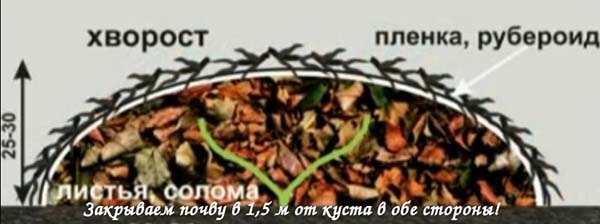
Note! Before you cover your grapes in the fall, you need to properly prepare them for winter. For this it is recommended to carry out a range of autumn vine care activities, namely: cut it, removed from the trellis, to treat diseases and pests, and also do not forget the moisture charge earlier and feed.
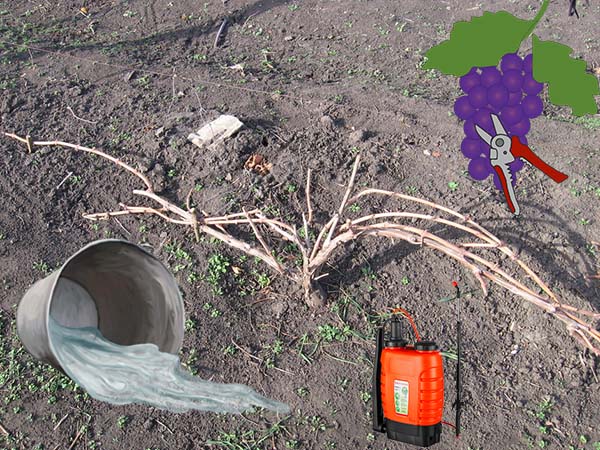
Tips for proper cover
A few tips for properly preparing the vine for shelter and direct warming of the grapes for the winter:
- Grapevine desirable not put on damp ground, and better for some old boards, plywood, polystyrene or even spruce branches. Although, according to some growers, on the contrary, it is better not to isolate the vine from the heat of the earth.
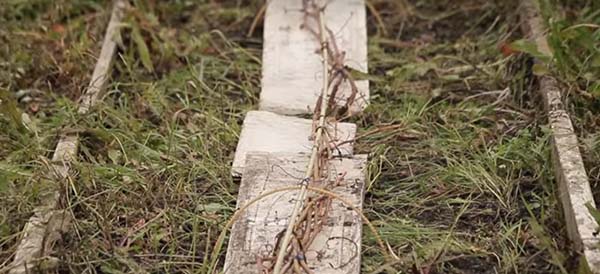
- Still sometimes, bars are placed under the vine so that it does not end up in the ice if melt water suddenly collects below.
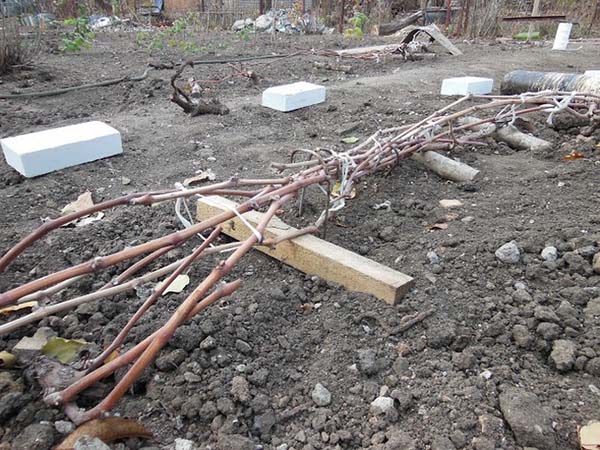
- Pin the vines to the ground it is possible using metal staples made of thick wire. The vine must be securely anchored so that it does not accidentally straighten up and break the cover.
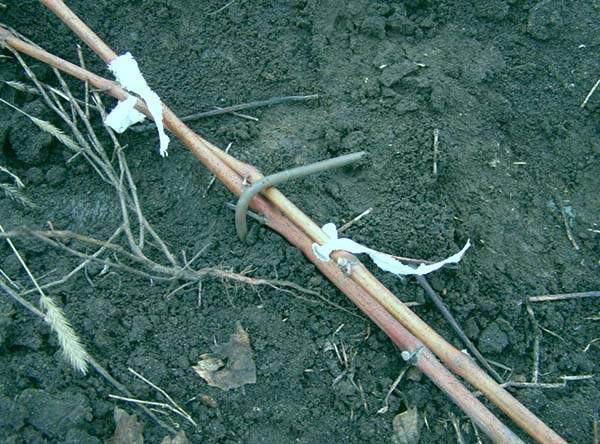
- The vine follows lay lengthwise along the row. Not desirable her twist, for example, into rings. Moreover, it happens that you can even hear the crunch of perennial sleeves, since the bark and wood in them are slightly broken. The bottom line is that juice can flow out through these microcracks in the spring, besides, spores of fungal diseases and bacteria can easily enter the shoots through them.
Advice! It is not advisable to lay the vine in deep grooves, during thaws and rains, water collects in them. It is much safer to simply lay on the ground and cover, so you can definitely avoid stagnant melt water.
- If you want the vine did not come into contact with the covering material, but there was a normal air exchange inside (air cushion)then you need set arcs either from glass-plastic fittings (does not rust, does not rot and does not need to be painted), or you can put a netting mesh.
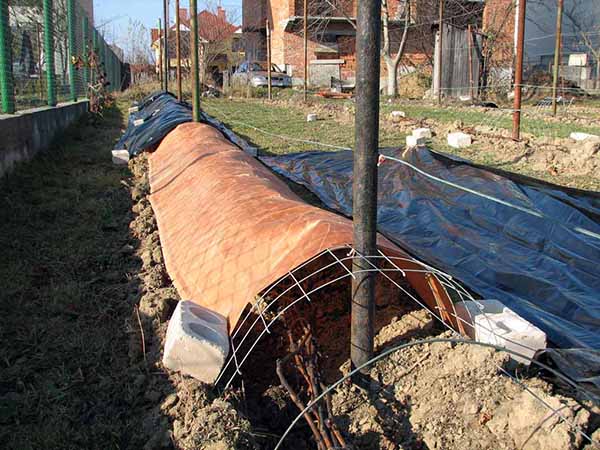
Important! The vine is first wrapped with an air-moisture-permeable non-woven material in order to prevent the greenhouse effect. The air cushion is made so that the film or other moisture-proof material does not come into contact with the buds, because they can rot from the formed condensation, and burn from the spring sun.
- For direct shelter of grapes, we need not only a material for insulation (to keep the heat and keep the vine warm), but alsomaterial to prevent moisture from entering under the shelter.
In this way! If you wrap the vine with non-woven material (agryl, agrocron or spunbond), which allows air and moisture to pass through, then you should understand that in the fall during rains and in spring when the snow melts, it will get wet through and through. The same goes for dry sawdust poured on the vine, which can also get wet, as a result of which they will not warm and protect from frost. therefore on non-woven material and sawdust, be sure to put a material on top that does not allow moisture to pass through, for example, it can be film, linoleum, roofing felt, slate, plywood or special waterproofing materials such as izolayka or izospan. In other words, it is imperative to ensure that it is always dry under cover in winter and spring.
- However, if in your area the winters are very snowy and very windy, then the vine needs to be insulated and additionally covered with moisture-proof materials. If the winters are not very harsh and with abundant snow, then it is enough just to dig in with earth, and throw snow masses on top. But if the winter is snowy and rainy, then both insulation (inside and from above with snow) and moisture protection are necessary.
Video: we cover grapes for the winter
Important! Ventilation holes should be left on both sides of the shelter (airs). Or it is necessary to periodically ventilate the vine manually (if you grow grapes where you live, because it is usually problematic to get to the dacha in winter), so that the grape bushes do not become moldy or stale during temperature changes (thaws).
Video: ventilation of covered bushes
How to cover grapes: the best covering materials
There are a lot of options for covering grapes, it all depends on what you already have on the site, whether you have extra money to buy special covering materials, your growing method and the characteristics of the climatic zone.
Heat-insulating covering materials for grapes:
- Earth;
- snow;
- agrofiber and non-woven fabric (spunbond, agril or agrocron);
- mulch (sawdust, foliage, straw, reed, spruce branches);
- old blankets;
- cardboard;
- polypropylene bags.
Waterproofing covering materials for grapes:
- film;
- linoleum;
- plywood;
- roofing material;
- slate;
- isolayk or isospan.
Shelter by the ground
The easiest and most natural way to hide grapes is to bury them in the ground. When the moment comes, you need to fill the previously pinned vine with a 20-centimeter layer of soil, which should preferably be dry, in other words, prepared in advance. Or you can take the land directly from the aisles.
Important! If you are going to cover the bushes with earth, then the shelter must be carried out before the upper layer of the soil freezes, because if the earth is frozen, then it will be practically impossible to cover the bushes with earth.
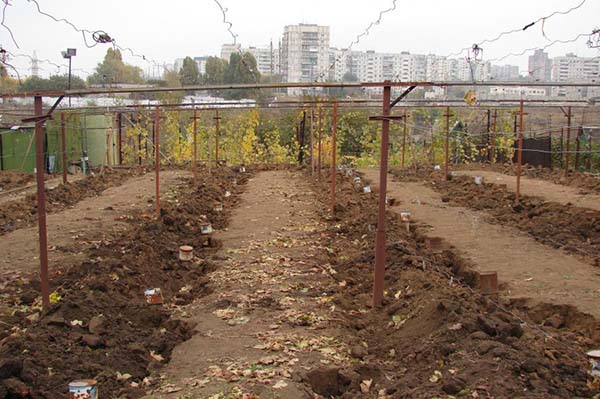
Attention! You can cover the grapes with earth only if it is not water-intensive and not heavy. The fact is that if the ground is constantly wet, then the vine will grow moldy and be affected by fungi.
It is advisable not only to bury the grapes in the ground, but also to additionally place on top of it some material that does not allow moisture to pass through, for example, the same slate.
And if you have snowy winters, then God himself ordered you to pour snow over the ground.
However! Digging has some significant drawbacks: it is very laborious, there is no ventilation, there is a high probability of damage to the vine during spring digging.
Although! Covering with the ground is a very good physical exercise to strengthen your health.
Snow shelter
If you live in a private house and grow grapes, so to speak, close by, then the best way would be to cover the grapes with snow. Of course, provided that there is a sufficient amount of it in your climatic zone.
It is advisable to pour snow on top of the shelter, for example, if you covered the vine with earth. Or you can simply throw snow masses over the laid and bent grapes.
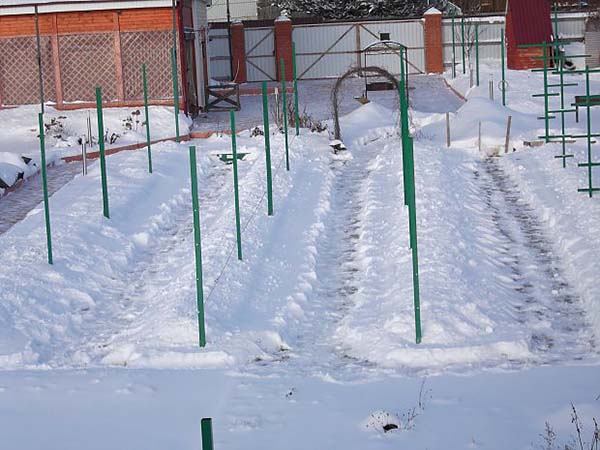
Moreover, the more snow, the better (every 10 centimeters is an additional +1 .. + 2 degrees of heat).
Should I cover grapes with sawdust
Sawdust are quite suitable for sheltering grapes for the winter, but besides them, you also you will definitely need a covering material that does not allow moisture to pass through.Sawdust well keep the vine from frost, provided that they are covered on top with a film, linoleum, roofing material, slate or special waterproofing materials, such as Isolayka or Isospan. The fact is that if the sawdust gets wet and freezes, then they will no longer warm and protect from frost, which will certainly lead to damage to the kidneys and, possibly, even the vine.
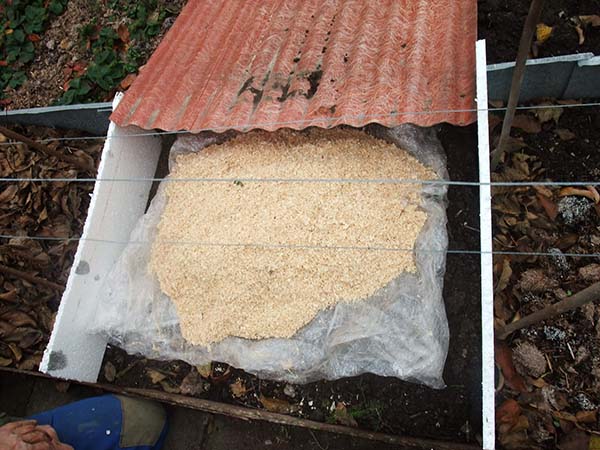
If you do everything correctly, then in the spring you will not have to rush to remove the shelter, since the sawdust will be dry and the vine will not vanish.
Essential minus: mice love to rummage in warm sawdust. However, if the vine is completely covered with sawdust, then the mice will definitely not climb. But if at least somewhere there is a bare vine, then the rodents will certainly arrange a feast for themselves.
Shelter with spruce branches
First you need to cover the grape bush with coniferous branches, then you can send it with sugar or flour bags, and then make a 10, or better 20-centimeter layer of the earth.
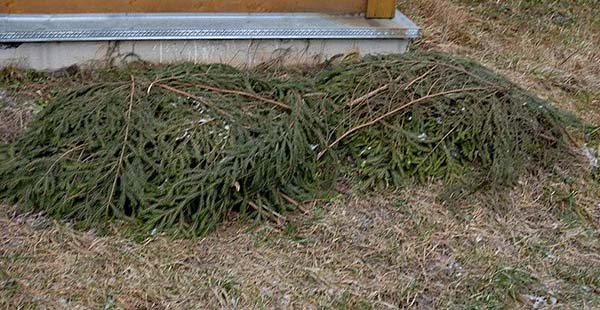
Shelter in foliage or straw
First, the vine must be bent to the ground and secured with iron hooks. Then pour fallen leaves into garbage bags (preferably 100-120 l) and tie. As a result, you will end up with foliage mats. Directly with them, in fact, you need to cover the grapes.
In the spring (around April), the bags will need to be removed, arched and covered with non-woven material until the end of returnable frost (until the second half - end of May)
Minuses: the method is applicable if you have only a few bushes, for a large plantation such a shelter is too troublesome (where you will find so many leaves).
Similarly, you can use straw.
In regions with little snow, foliage is often thrown over the main shelter.
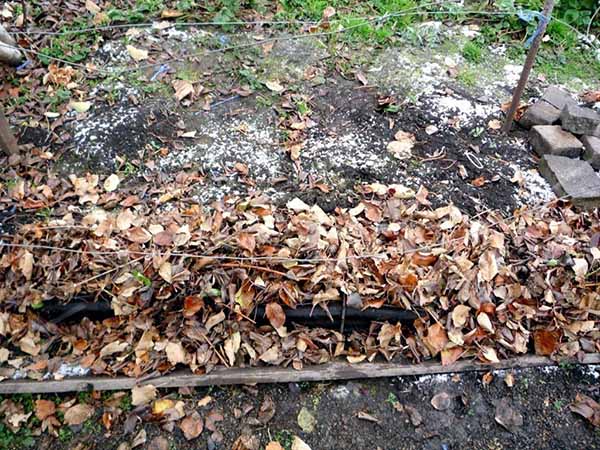
But in general, leaves and straw, as a rule, are used as a mulching material for better preservation of heat, and arcs are already installed on top, on which a moisture-proof covering material is laid.
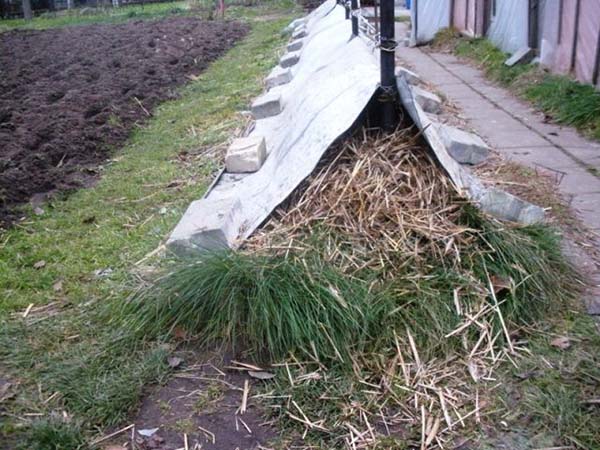
Note! In deciduous shelters made of straw, mice also often like to rummage, especially if the vine will look out, so you need to completely cover the bushes.
Can I cover with cardboard
Cardboard is not the best material for sheltering grapes, it gets wet and quickly deteriorates, so such a shelter cannot be called reliable.Although, if it is additionally covered on top with a film or other material that does not allow moisture to pass through, then this method has a good chance of existence.
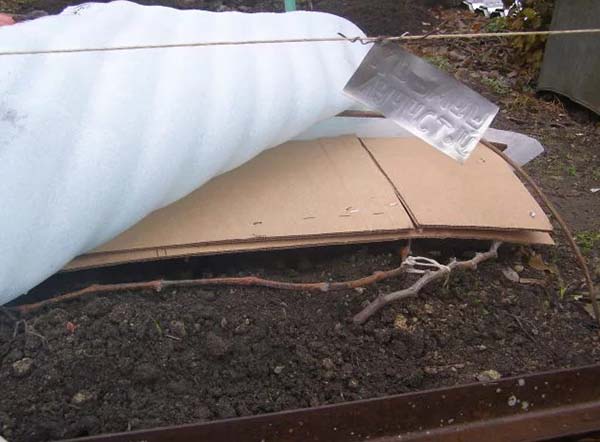
Shelter with polypropylene bags
Polypropylene bags made of sugar or flour are another great shelter material (but be aware that polypropylene is not airtight).
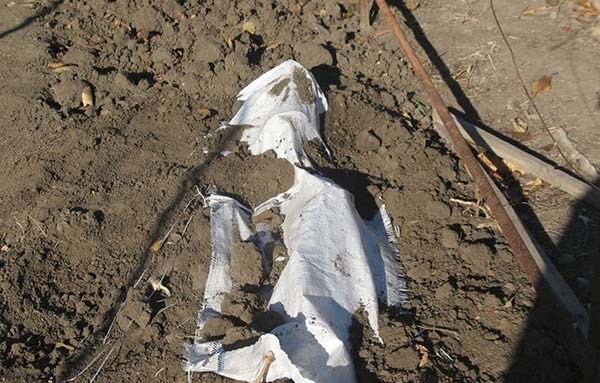
Take the bags and cover the already laid vine, and then sprinkle with earth. And over the ground you can additionally put slate (from excess moisture).
Video: covering grape bushes with polypropylene sugar bags and earth
Shelter with slate
Just place the grapes on the ground and cover sheets of ordinary slate... Optionally, for additional insulation, you can pour dry hay and leaves on top of the slate.
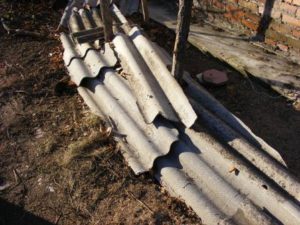
pros this way: in this position, the vine does not shrink and can, in principle, be open only in April-May, thereby bypassing the return frosts in spring. In addition, slate can be used as a covering material for several years.
However, if you carelessly handle, then the slate can be broken, and the pleasure is not cheap.
This method is suitable for climatic zones where the frost is not too high!
Or as an option for a warmer shelter for the northern regions - you can first to lay the vine in a ditch (about 20 cm deep), wrapped in burlap, cover with slate, and on top more additionally cover with earth.
Video: sheltering grapes for the winter with slate
Shelter with roofing material
The grapes are laid on the ground and pinned, covered with burlap (or some other non-woven insulation), and then the roofing material is spread.
This material suitable for hiding in regions with little snowy winters.
Pros of using: easy to spread and clean, durable.
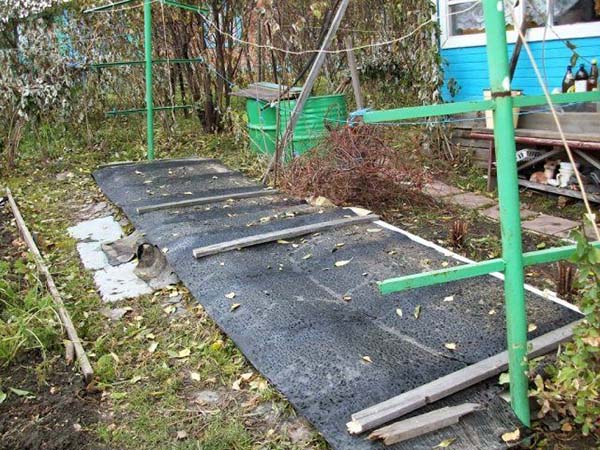
Advice! If you do not want your grapes to dry out under such an airtight roofing material cover, then at the edges of the ditches you should always leave open areas for ventilation or ventilate yourself.
Covering with roofing material in more snowy regions can be different. At first cover the vine with leaves (or other mulch), and then make a pyramid from roofing material.
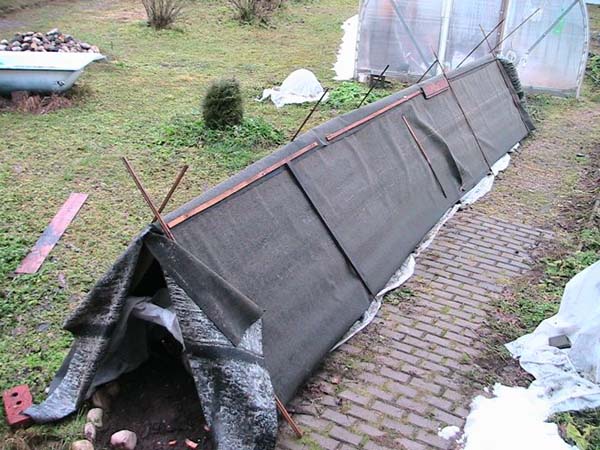
Covering with a film
So, bend the grapes and pin them to the ground. Then put arcs that can be made from a chain-link mesh,cover with agrofibre or spunbond (you can over the arcs, or you can wrap the vine), and already from above you cover it with a film (better than light shades, but you can also black), which should be fixed on the side with bricks or boards, or sketch out the earth.
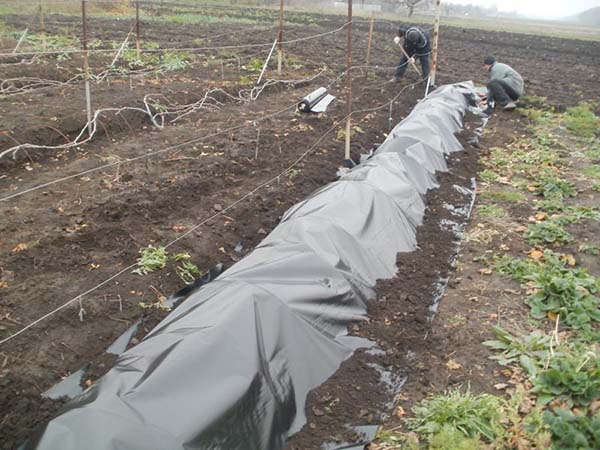
This way arch shelters also called tunnel.
Video: easy cover of grape bushes with film
Answers to popular questions about sheltering grapes for the winter
Below you can find answers to the most pressing and common questions about sheltering grapes for the winter.
How to properly cover young grapes for the winter
Harbor newly planted grape seedlings (for example, this fall) much easier. Cover the seedling with a bottle (1.5-liter or 5) with a cut bottom and an open neck and cover it with earth (make a mound) so that there is a 5-10 centimeter layer of earth on top.
How old to cover grapes for the winter
Another fairly popular question of novice winegrowers, the answer to which is quite obvious - you need to cover every year, regardless of the age of the grapes.
How to cover grapes growing on an arch or arbor
However! Very old and neglected grapes growing on the "arch" (arbor), which can not be laid on the ground for insulation, in principle, you can not cover. In general, for this growing method, as a rule, the most frost-resistant non-covering varieties are chosen.
If it is necessary to cover, then you can try to wrap the vine in a non-woven material or agrofiber right in an upright position.
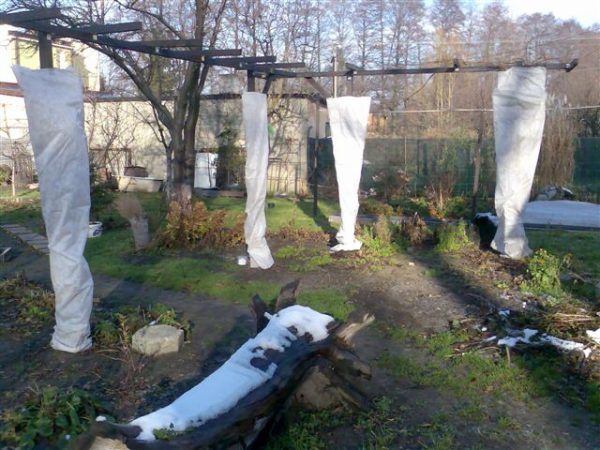
Major mistakes
In short, the most popular mistakes that beginner growers make when covering the vine for the winter are most often:
- improper preparation of grapes for shelter;
- failure to comply with the terms and basic conditions for the shelter;
- the wrong way of shelter for a particular region;
- lack of ventilation or excessive moisture insulation.
Now you know how to properly and reliably cover grapes for the winter. You just need to decide on the most suitable method and get down to business!
Video: how to cover grapes for the winter
Folk wisdom! It is imperative to cover the vine, if possible. And if there is no opportunity, then you need to make every effort to make such an opportunity appear 🙂

